The importance of strategic planning for the survival of hotel entrepreneurships
Georgios Papadogoulas
Tourism Management Department, University of West Attica
ABSTRACT
The importance of strategic management in modern society, where organizations need to adapt to uncertain environments to survive has been intensely discussed. The development of a strategic plan through strategic management is crucial for the survival of businesses in today's competitive environment. We are examining the suitable process under the scope of understanding, recording and functioning of the inner and outer environment of the business.
The stages are presented clearly following data that has been collected through bibliography stating the survival of the business itself as representative of a defined project. The mission and the vision of the entrepreneurship is analyzed through the operational functions as well as culture and dominant system of beliefs and values.
The evaluation of strategic planning is presented through reviewing and assessing the defined goals and factors that may appear.
Determination of qualitative and quantitative standards, analysis of the potential deviations and identification of corrective actions are named as the crucial stages of the evaluation
KEY WORDS: Strategy, administration, vision, planning, profitability, market share
Introduction
Strategic Planning
The importance of strategic management in modern society, where organizations need to adapt to uncertain environments to survive has been intensely discussed. (Stylianides&Pashiardis, 2007). The development of a strategic plan through strategic management is crucial for the survival of businesses in today's competitive environment. (Tsiakkiros&Pashiardis, 2002).
The concepts of strategic management and strategic planning, highlight the importance of strategic foresight and the formulation of alternative scenarios for the future. Strategic management is a set of processes, concepts, and tools that leaders use to think, act, and learn strategically.
The terms strategic management and strategic planning are used interchangeably, even though strategic planning focuses on future goals and decision-making in a constantly changing environment. (UNESCO, 2010)
The survival of the organizations is highly depended on strategic planning (Pashiardis, 1996) which has been a accumulation of procedures, meanings and tools in order strategic thinking to be achieved (Bryson 2004).
Important factors for success of an organization has been strategic foresight and alternatives for the future as important factors for dealing with successful decision making procedures (Tsiakkiros,2015α).
According to Olsen και Eadie (1982), a basic factor of strategic planning has been the definition of vision for the organization, a means of predicting future situations through objectives vision.
Definitions
Several definitions have been presented in the international and Greek literature and articles to articulate the concept of strategy. For the first time, the term strategy was mentioned in Newman's book (1951) when business management researchers realized that companies that compete in the same industry and use the same technology present different levels of performance.
According to Chandler (1962), strategy is the determination of the company's long-term goals and objectives, the adoption of a series of actions, as well as the identification and allocation of necessary resources and means to achieve the defined goals.
Similarly, according to Hofer and Schendel (1978), strategy is the alignment that an organization makes between its internal resources, capabilities, opportunities, and the risks created in the external environment.
According to Quin, "Strategy is the plan that integrates the basic objectives of a business, policies, and actions into a unified whole. A properly defined strategy helps manage and allocate the resources of a business based on its internal capabilities and advantages, expected changes in the environment, and relevant competitive moves" (Quin, 1980).
Kenneth (1981) argues that strategy involves the identification of goals, the formulation of policies and plans to achieve these goals, and the allocation of resources to implement the plans.
Ansoff (1985) thinks that strategy is a common line among procedures of the organization and its products or its markets that are responsible for the nature of the organization itself during the past, present and future.
"Finally, one of the most prominent academics in the field of business strategy, Harvard professor Porter (1996), defines strategy as the process of producing different products from competitors or doing the same things differently.
From the above, it becomes clear that strategy is not a set of programmed rules and instructions. Strategy coordinates and directs the independent decisions of an organization, with the primary purpose of successful navigation through the guidance of administrative decisions for the acquisition and maintenance of competitive advantage. It is, therefore, integrated actions that aim to balance the strengths and weaknesses of the organization, taking into account the opportunities and threats presented by the environment, in order to achieve the purpose of the enterprise according to the values, ambitions, and beliefs of its executives. (Mintzberg, 1987)
The characteristics of the strategy that contribute to success are as follows:
• Simple, consistent, and long-term goals
• Clear understanding of the competitive environment of the entrepreneurship
• Objective assessment of the resources of the enterprise
• Effective implementation of the evolving strategy
Chart1:Rational Programming of Strategic Business Planning
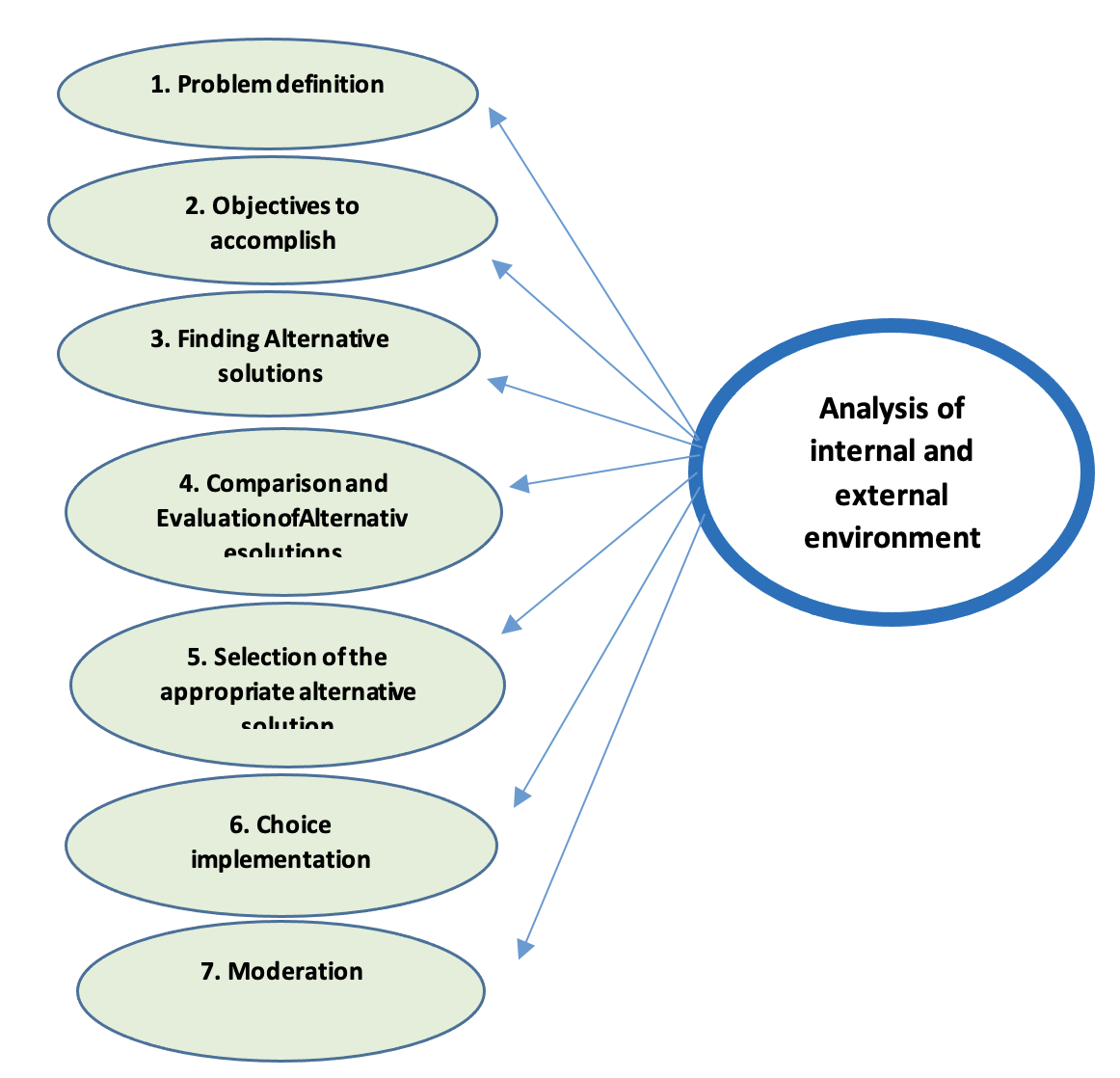
Strategic Design - Process The process of strategy
The process of strategic planning involves understanding, identifying, and analytically recording the internal organization and functioning, as well as the conditions of the external environment of the business. During the stages of the process, the direction of the strategic development of the business is defined and applied with the aim of fully satisfying its needs.
The first stage for shaping the strategic direction involves analyzing the potential strengths, weaknesses, opportunities, and threats of the overall environment of the business (SWOT analysis, PESTEL Analysis), followed by the design and organizational plans of the strategy, which are evaluated in the end. (Enz, 2011).
The stages of strategic planning include: a) strategic analysis, where an attempt is made to understand the existing situation of the business, b) strategy selection, where the possible actions are processed and the future directions of the business are chosen, and c) implementation of the selected strategy (Therios, 2002).
Chart 2:The Process of Strategic Planning for a Business
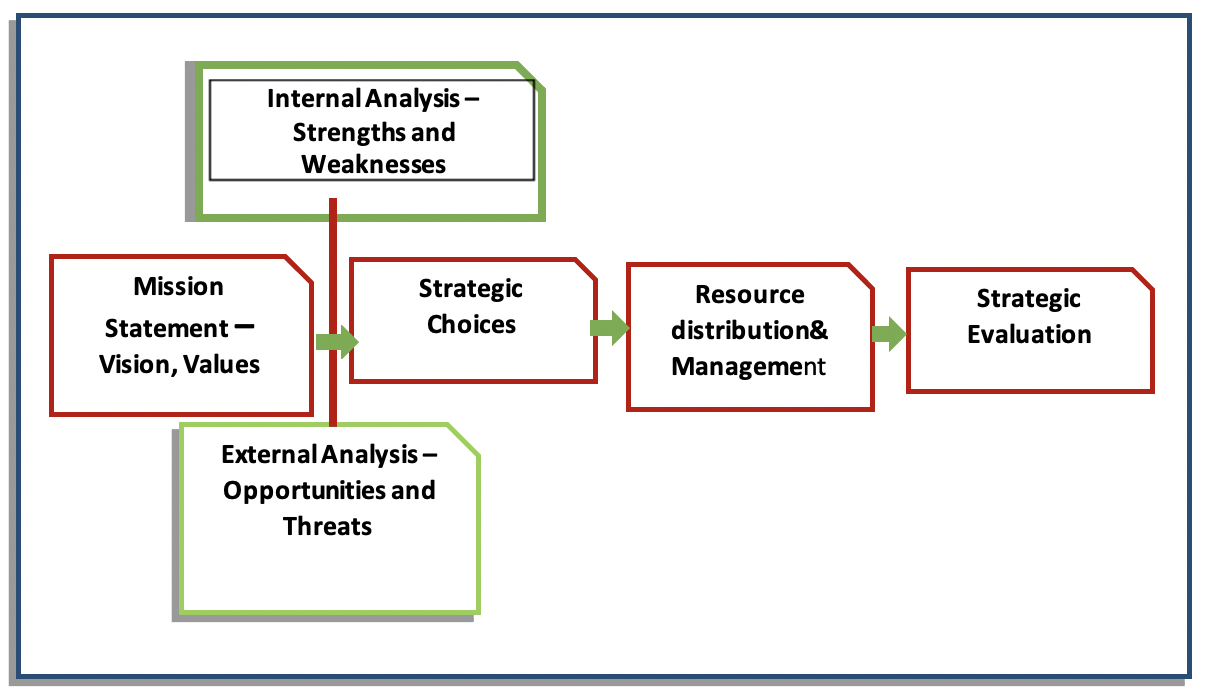
Goal setting
Through defining their vision, businesses have the ability to determine their future direction and desired endpoint (Figure 3). The effectiveness of the operational vision requires the following characteristics (Papadakis, 2016; Schermerhorn, 2012):
• Clarity
• Realism
• Alignment with the business culture and values
• Brevity for easy recall by personnel
• Understanding and spirit of collaboration from all parties involved in the business.
The mission of a business reflects simultaneously its presence in the market, the distribution of its operational resources and the development of certain required skills for stabilization and expansion. The mission is a representative characteristic of the overall project for the effective achievement of strategic planning and a defined business model (Kourtis, 2004). The existence of a clear mission, based on the operational functions of a business, can contribute to the stable course and inspire confidence in all involved groups, such as customers, employees, suppliers, shareholders, executives, etc.
The mission and vision of the business are usually intertwined with the culture and dominant system of values and beliefs, and consequently functional objectives, directions, strategies, and performance of business activities are created (Papadakis, 2016; Schermerhorn, 2012).
- • Profitability
- • Increase and positive performance of financial capital
- • Efficiency of expenses and resource allocation with the goal of operating at a lower cost
- • Prompt response to customer needs and continuous service
- • Maintenance of product and service quality
- • Acquisition of a specific market share
- • Acquisition and continuous training of capable human resources
- • Development of innovative and pioneering products and processes
- Understanding and undertaking of social responsibility
Chart3. Strategic Planning Pyramid
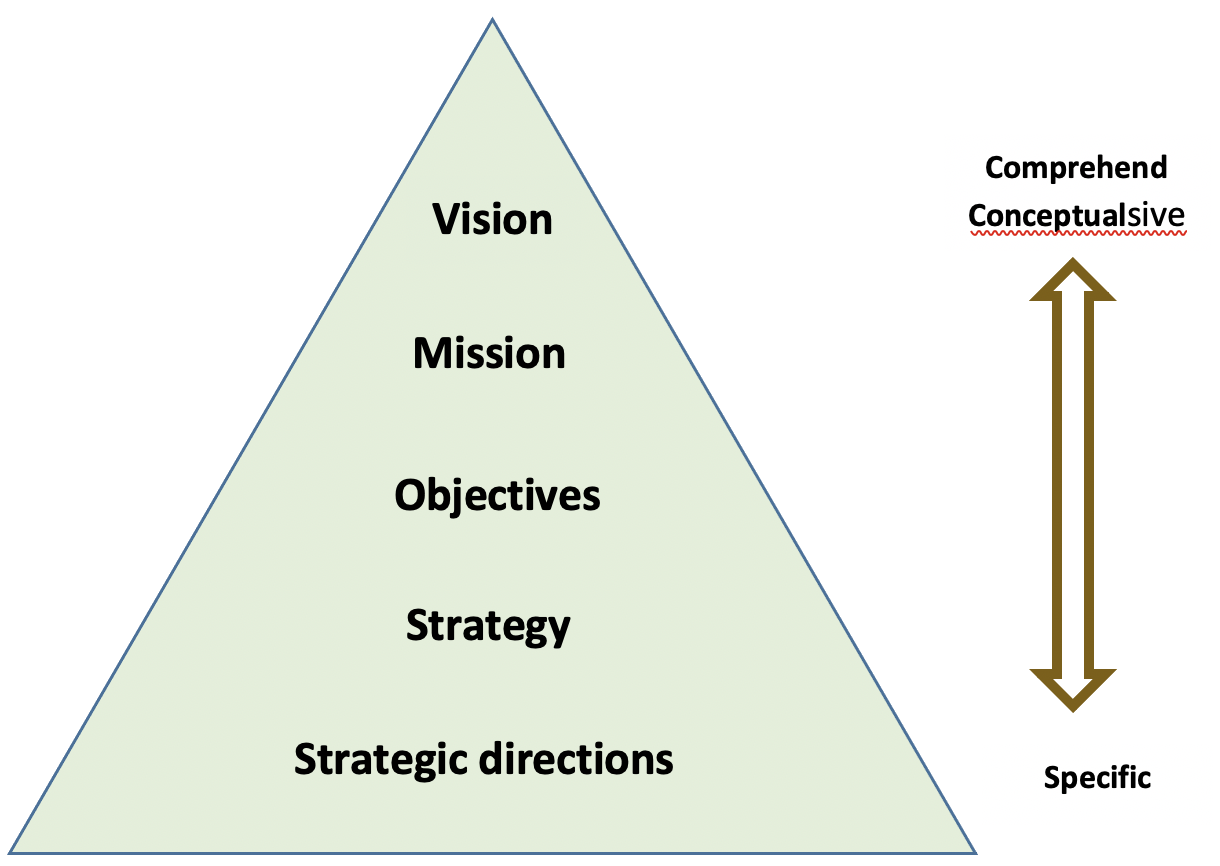
Strategic analysis of the internal and external environment
To determine and define the appropriate strategy for a business, an analysis of its internal and external operating environment (SWOT Analysis) is required. The information gained through clarification and analysis of the strengths, weaknesses, opportunities, and threats of the environment can contribute to the success of the mission and defined goals of the business (Figure 4).
The internal environment of the business concerns the analysis of its resources and systems, such as technological knowledge and human capabilities, organization, profile, and characteristics of the business, as well as its financial ability. The analysis of the external environment involves identifying variables such as competition, legal environment, market and investments, technological progress, consumer trends and preferences, economic conditions, and adapting the business to them (Kourtis, 2004, Papadakis, 2016, Thompson & Stickland, 2005).
Chart4.SWOTAnalysis
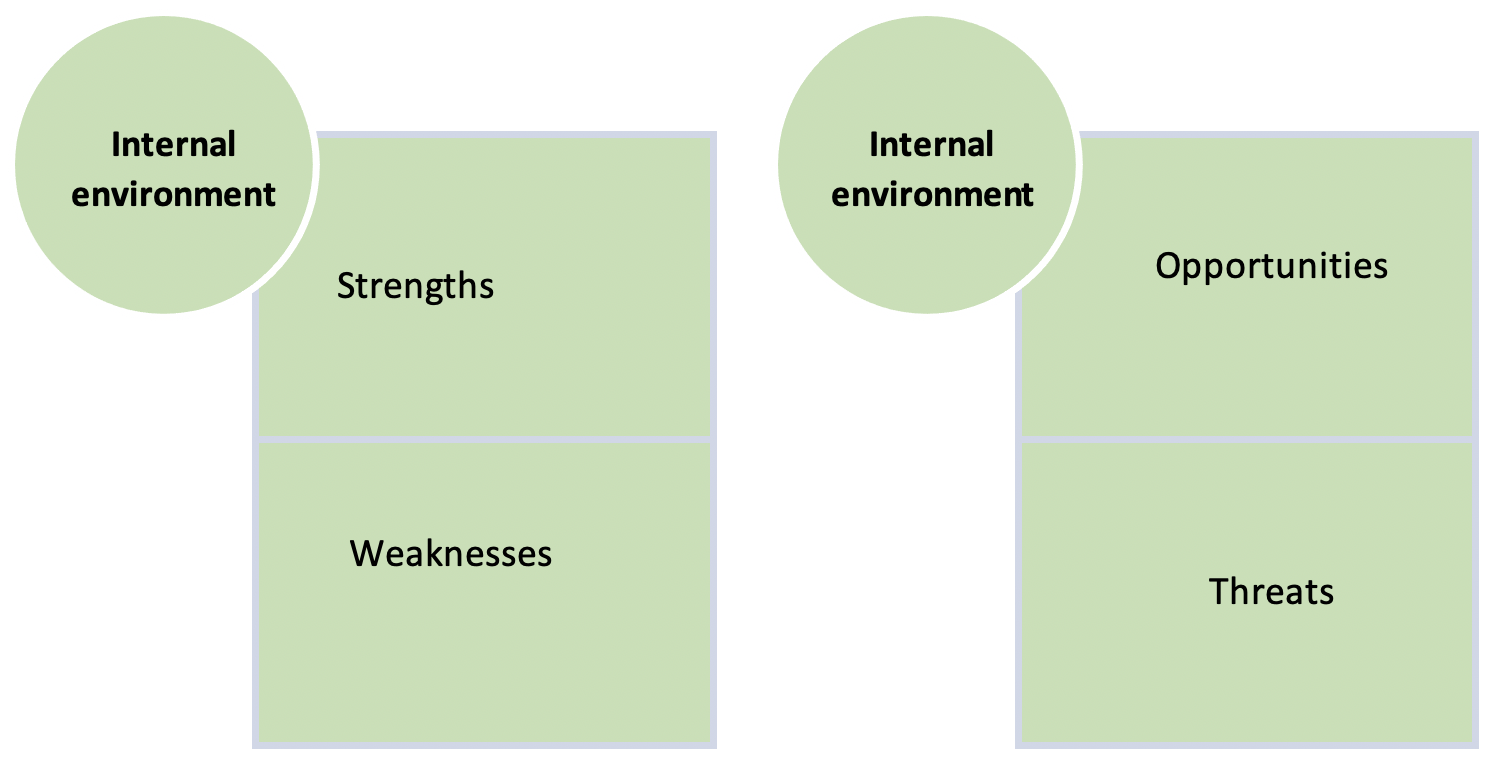
Πηγή:Thompson&Stickland,2005
The complexity and variability of a business's external environment affects its perception and adaptability. In order to explore the strategically significant opportunities and threats to a business's operations, the external environment is taken into account, including the level of the immediate market environment and the level of the broader macro-environment (PESTEL analysis). At that specific stage of the strategic planning process, the business can evaluate its competitive position within the industry, identify the positions of its competitors, and identify and understand the stage of market development, potential changes, and their impact. In this process, an analysis is conducted of a series of systems and structures that affect the operation of a business and are crucial in shaping strategic decisions. These systems relate to the business's external environment and include the social, political, geographic, cultural, environmental, legal, demographic, and technological environments (Papadakis, 2016).
Chart5.PESTELAnalysis
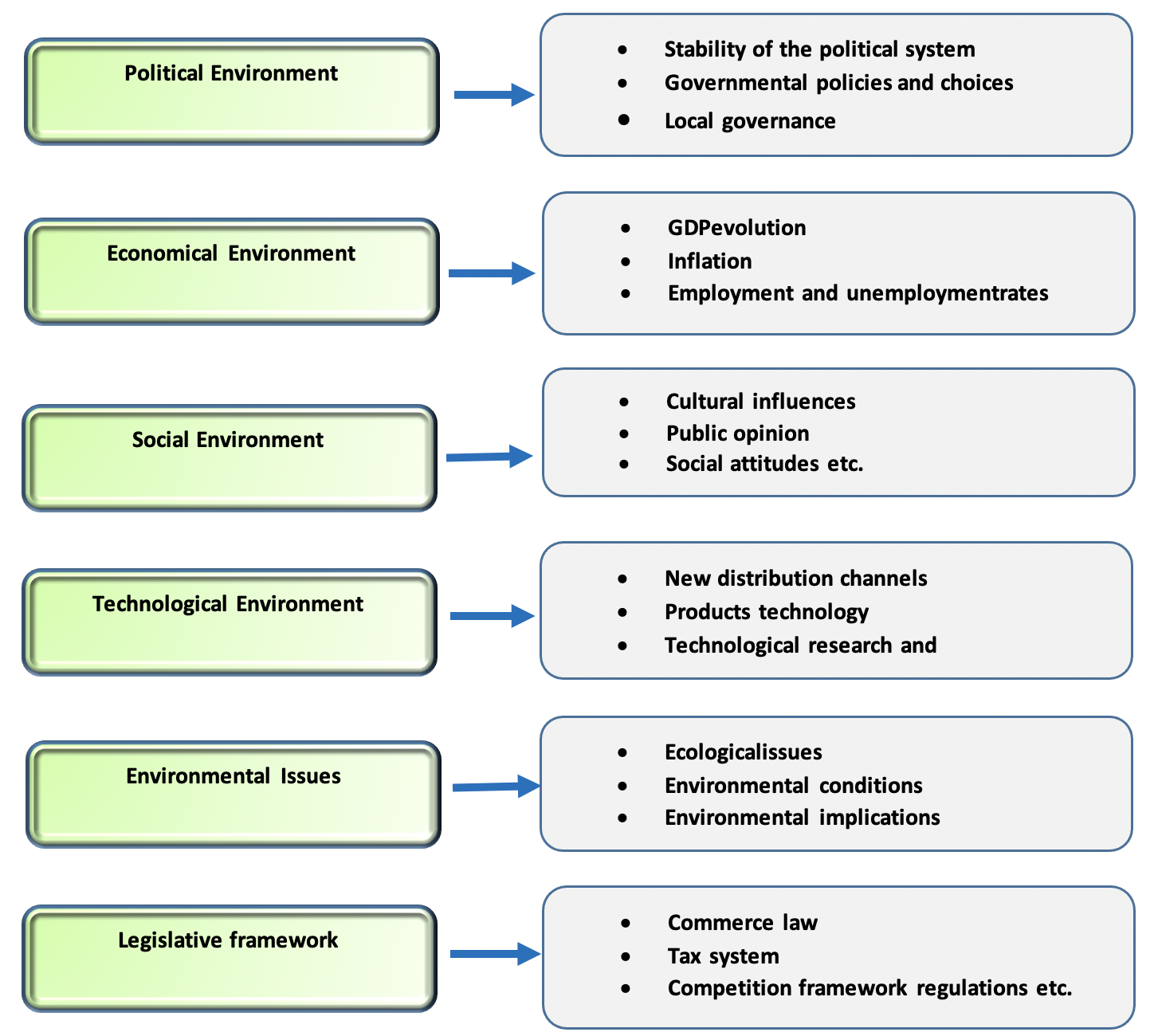
Source: Papadakis, 2016
For the development of competitive advantages of the business, the analysis of the internal environment is equally important. This includes the identification of the business's resources, capabilities, and competencies, which can be a source of sustainable competitive advantage (Barney, 1991).
The analysis of material, financial, and human resources for identification and determination of their quality, quantity, and availability will guide the design of the company's strategy, regarding the production of products or the provision of services, as well as the degree of influence and modernization of the changes and existing and expected opportunities of the external environment. At the same time, the analysis and evaluation of the strengths and weaknesses of the internal environment will help identify deficiencies and apply the necessary actions and investments to correct them (Kourtis, 2004).
Formulation of Strategy
The next step for a company after analyzing the environment is the selection and formulation of its strategic function and development, aiming to achieve its goals and vision. In order for the company to coordinate the actions and directions of the strategy, a process of consistent, sequential, and ongoing strategic planning is followed. The formulation of the company's strategy is based on the results of the analysis of the internal and external environment and focuses on identifying its strengths, weaknesses, opportunities, and threats to determine the course of action that will help it achieve its goals.
The choice of strategy is reflected in the selection of suitable business actions and activities to achieve functional objectives. At a practical level, effective implementation of the strategy requires the mobilization of resources and the management system of the enterprise, while at the same time, the existence and contribution of support structures are required, as well as the correct distribution of tasks and work flows, as well as the inspiration of capable and appropriate human resources (Schermerhorn, 2012, Enz,2011· Papadakis, 2016).
In many cases, operational objectives and objectives are not clearly defined, internal resources are limited, the possibility of alternative options is unstable, information about the external and macroeconomic environment is insufficient, while the abilities or behavioral parameters (e.g. selfishness, willingness, etc.) of human resources affect the shaping of the strategy. The result of this is that the shaping of the strategy escapes the rational planning process, and the enterprise is led to a dead end and the need for readjustment.
In order to create conditions for long-term sustainability, the planning model works more efficiently in businesses characterized by a stable environment, clear objectives, and available resources. The effectiveness of the strategy also depends on the ability to adapt to changes in the external environment and to the needs of the market. The success of the strategy is not only measured by achieving short-term objectives, but also by creating a long-term competitive advantage for the enterprise.
Chart6.Achieving strategic resource allocation
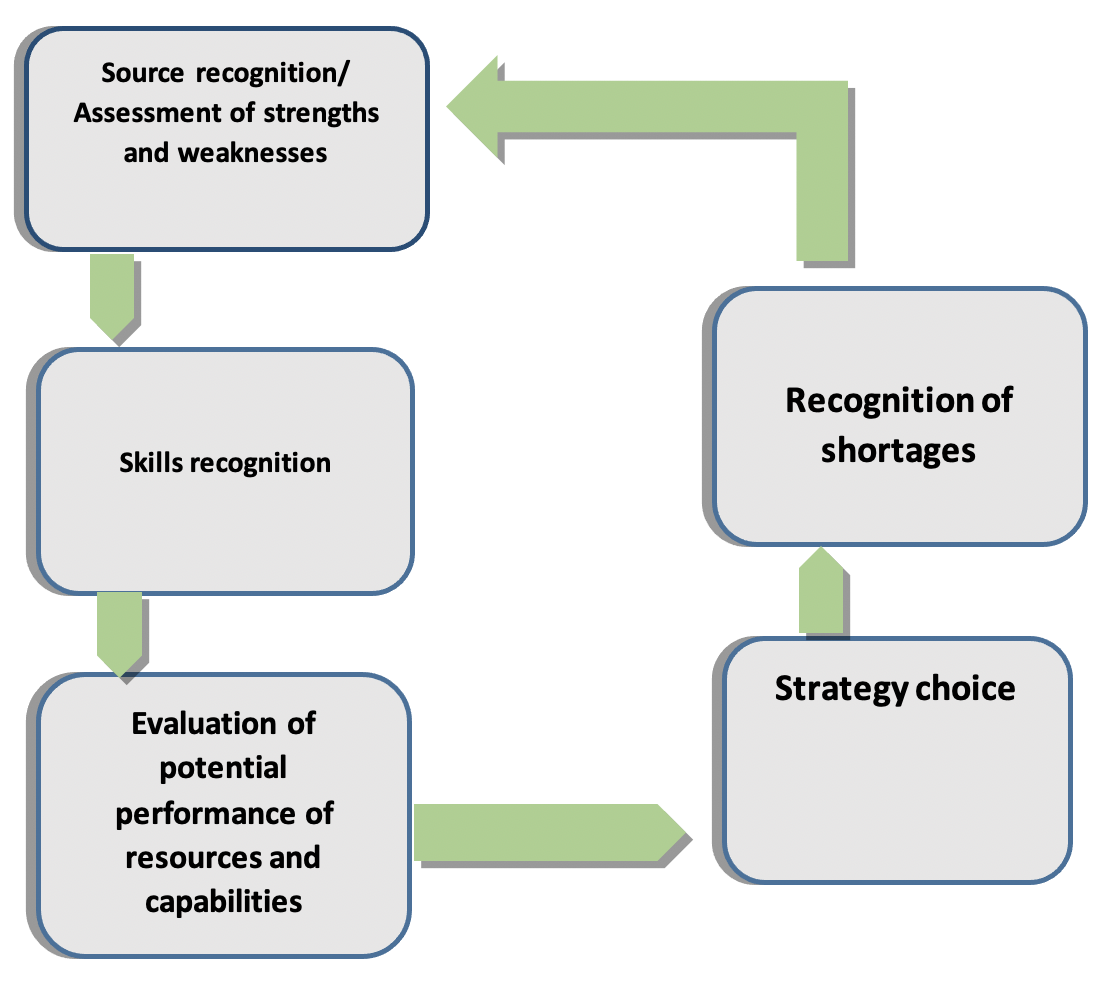
Source:Papadakis, 2016
Strategic Evaluation
Strategic evaluation is the final stage of the strategic planning process and involves the strategic review and assessment of the initial plans to fulfill the defined functional goals, which includes the following points (Papadakis, 2016; Schermerhorn, 2012):
• Determining standards, such as qualitative and quantitative criteria
• Measuring performance against predetermined standards
• Analyzing potential deviations and defining acceptable variations
• Identifying and taking corrective actions, which may involve redefining the initial goals or reformulating the strategy through the initiation of the process.
The measurement of results needs to be carried out at predetermined and regular intervals to identify and address potential problems in a timely manner. Specific control stages are followed for measuring results, such as behavior control, measurable results control, and resource control at the quality level (Papadakis, 2016).
The stage of evaluating a business's strategy aims to answer whether the predetermined goals have been achieved.
Specifically, it is evaluated whether the objectives, direction plan, policies, and results of the strategy have been achieved satisfactorily. The criteria for evaluating the strategy, according to which the agreement of the applied strategy with the existing situation and the performance of the business is examined, are as follows: consistency with operational objectives, agreement with changes in the external environment, creation and maintenance of a competitive advantage, feasibility of implementation.
For the feasibility criterion, the business examines the relationship between the strategy and its compatibility with its resources (financial resources, human resources capabilities and skills, natural resources). The suitability of the strategy is checked in relation to the fundamental capabilities and resources of the business, in order to verify the principles and alternative options of the applied strategy.
The strategy followed, as well as the performance of the business, needs to be in line with the standards set by the administration. In many cases, the suitability of the applied strategy at that time, is the primary variable that determines the failure or success of the results of the strategy (Johnson et al., 2008, Papadakis, 2016).
Efficiency of control and evaluation of the applied strategy depends on the understanding and degree of trust towards it by management and human resources, as well as on the reciprocity and common sense of cooperation development among the executives of the administration and stakeholders. Proper resource utilization results in less burden on the economic performance of the enterprise and its human resources (Papadakis, 2016).
BIBLIOGRAPHY
- AnsoffH.I., (1985).¨CorporateStrategy¨,LondonPenguin
- Bryson, J. M. (2004). Strategic planning for public and nonprofit organizations: A guide to strengtheningand sustaining organizational achievement (3rd ed.). San Francisco, CA: Jossey-Bass.
- Chandler, A.D. (1962).Strategy and structure : chapters in the history of the American industrial enterprise, New York: Doubleday
- Enz, C. (2011). “Competing successfully with other hotels: The role of strategy”. In Sturman, M., Corgel, J. &Verma, R. (Eds.), The Cornell School of Hotel Administration on hospitality: Cutting edge thinking and practice, pp. 207 – 226. New York: Wiley.
- Hofer, C. W. &Schendel, D.(1978). Strategy formulation: Analytical concepts. St. Paul,MN: West
- Johnson, G., Scholes, K. and Whittington, R. (2008).Exploring Corporate Strategy: Text and Cases. 8th Edition, Prentice Hall, Harlow.
- Georgia Kyritsi, Ioulia Lazoura, Sergopoulos Konstantinos, Nikolaidis Nikolaos“Customer behavior of tourists in midst pandemic and its administration from human resources department of hotel entrepreneurships”(http://jotr.eu/index.php/volume25-2/294)
- Mintzberg, H. (1987). The Strategy Concept 1:5 Ps for Strategy. California Management Review, 30, 11-21. http://dx.doi.org/10.2307/41165263
- Olsen, J., B., &Eadie, D. C. (1982). The game plan, governance with foresight. Washington, DC: Council ofState Planning Agencies
- Pashiardis, P. (1996). Environmental scanning in educational organizations: Uses, approaches, sources and methodologies. International Journal of Educational Management, 10 (3), 5-9.
- Porter Michael E. What Is Strategy? 37-55 harvard business review, november–december 1996
- Quinn, J.B. (1980). Strategies for Change: Logical Incrementalism. Irwin, Homewood.
- Schermerhorn, J. R. (2012). Introduction to Management. Broken Hill Publishers.
- Stylianides, M. &Pashiardis, P. (2007). The future of our schools: An example of the Delphi technique in action and the case of Cyprus, International Journal of Educational Management, 21(5), 384 – 406
- Thompson, A., Strickland, A. and Gamble, J. (2005). Crafting and Executing Strategy: Text and Readings. McGraw- Hill, New York.
- Tsiakkiros, A., &Pashiardis, P. (2002). Strategic planning and education: the case of Cyprus. The International Journal of Educational Management, 16(1), 6-17.
- UNESCO (2010). Strategic planning: Concept and rationale. Education Sector Planning Working Papers. Working Paper 1. Paris: International Institute for Educational Planning
- Θερίου,Ν. (2002). Στρατηγική διοίκηση επιχειρήσεων, Κριτική.
- Κούρτης, Π. (2004). Στρατηγικός Σχεδιασμός Επιχειρήσεων: μια συνθετική προσέγγιση. Διοίκηση και Οικονομία, τεύχ. 1, σσ. 219 – 245.
- Παπαδάκης, Β. (2016). Στρατηγική των επιχειρήσεων: Ελληνική και διεθνής εμπειρία. Αθήνα: εκδόσεις Μπένου.
- Τσιάκκιρος, Α. (2015α). Οργανισμοί και διοίκηση – Ανάλυση αναγκών. Στο Π. Πασιαρδής (Επιμ.), Διαχείριση αλλαγής, σχολική αποτελεσματικότητα και στρατηγικός σχεδιασμός-Τόμος ΙΙ: Στρατηγικός σχεδιασμός στην εκπαίδευση (σσ. 23-47). Αθήνα: ΕΛΛΗΝ.
